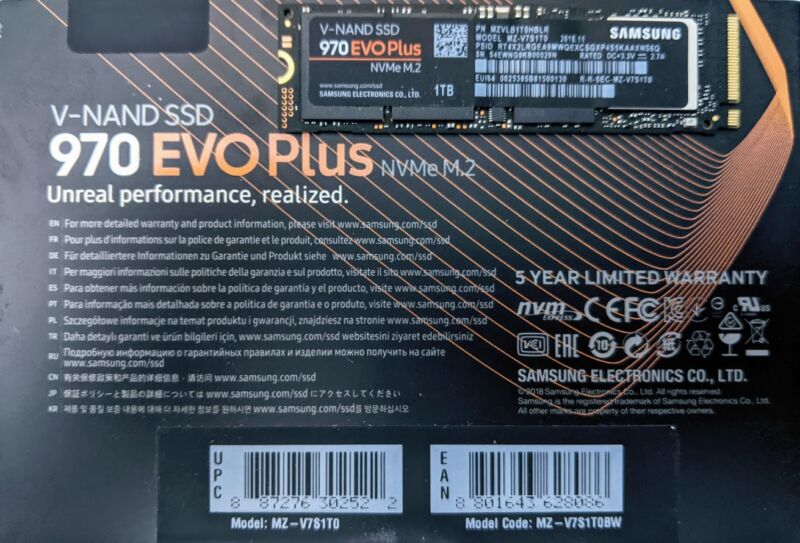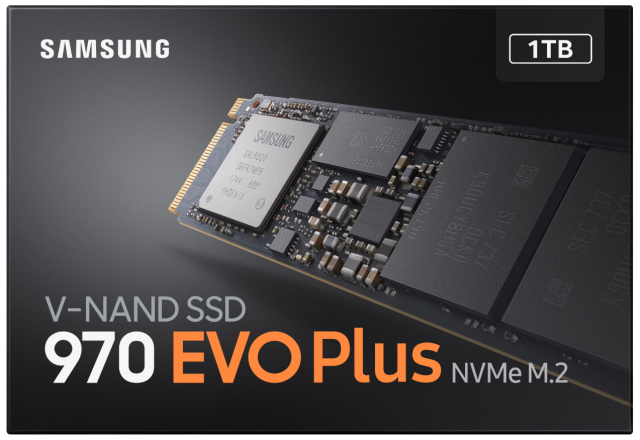
You can't see the part number which distinguishes the newer, slower drive from the older, faster one on the box—you need to check the PN field in the top center of the label on the drive itself.
Jim Salter
Recently, major SSD vendors Crucial and Western Digital have both been caught swapping out TLC NAND in their consumer SSDs for cheaper but much lower-performance, lower-endurance QLC NAND. Samsung appears to be joining them in the part-swapping corner of shame today, thanks to Chinese Youtuber 潮玩客, who documented a new version of the Samsung 970 Evo Plus using an inferior drive controller.
Although the consumer-facing model number of the drives did not change—it was a 970 Evo Plus last year, and it's still a 970 Evo Plus now—the manufacturer part number did. Unfortunately, the manufacturer part number isn't visible on the box the SSD comes in—as far as we've been able to determine, it's only shown on a small label on the drive itself.
Falling off the write cliff
-
This CrystalDiskMark test makes the newer, inferior drive look faster than the original in most tests—but notice the very small 1GiB test size. This test isn't escaping the SLC write cache!
-
In this HD Tune Pro test, we can see the "write cliff" effect on both drives as the SLC cache is exhausted—but the difference isn't HD Tune Pro vs CrystalDiskMark, it's 1GiB test vs 200GiB test.
-
We can also see the "write cliff" effect in a simple large file copy—when the write cache is exhausted, the new drive is far slower than the old.
We tested the 970 Evo Plus (alongside the 980, and the older 970 Pro) in March, clocking it at write speeds of 1,600+ MiB/sec on 1MiB workloads. Our benchmarking was done with he old version, part number MZVLB1T0HBLR. The newer version—part number MZVL21T0HBLU—is considerably slower. According to 潮玩客's test results, the newer version only manages 830MiB/sec—half the performance of the original.
It seems likely that Samsung, like Western Digital, hoped the part swap would go unnoticed because the end result was "good enough." Under most light usage workloads, a user might never notice the new part number's lower performance—because like nearly all modern SSDs, the 970 Evo Plus features a SLC write cache that's much faster than its main storage NAND, and the new part's performance drop doesn't become apparent until after the cache is exhausted.
潮玩客 first tested the old and new 970 Evo Plus drives using CrystalDiskMark, and the drives appeared near-identical. But that's because CrystalDiskMark by default uses a very small 1GiB test size, which clearly is not enough to exhaust either drive's write cache. (We at Ars frequently use CrystalDiskMark—but we select larger test sizes, for precisely this reason.)
In longer tests, both drives decrease sharply in performance as cache fills, which is expected. But while the older drive retains nearly two-thirds of its original performance, the newer version craters to less than a third. We can see this effect not only in artificial benchmarks, but also in large file copies, as seen in 潮玩客's later tests.
The controller is the culprit

Ironically, Samsung's own store page for the 970 Evo Plus clearly displays the missing Phoenix controller.
The best news for impacted 970 Evo Plus owners is that they should "only" be taking a massive performance hit, without a corresponding decrease in write endurance. That's because unlike Crucial and Western Digital's part-swaps, Samsung didn't drop from TLC flash to QLC—it just swapped out the controller.
The older, higher-performing drives have a Phoenix controller and the newer, lower-performing drives use one made by Elpis. Tom's Hardware points out that Samsung is already known to be facing controller shortages, with its own Texa controller factories having been idle since February.
Although Samsung's part swap will likely have a lower direct customer impact than Western Digital's or Crucial's, it's still disappointing that the company is pulling this without informing the public. Ultimately, we're talking about two versions of the same model with significantly different components and a drastic reduction in performance, with very little way for a customer to spot the difference—and pandemic or no pandemic, that's just not okay.
潮玩客's original video is here—but you won't get the most out of it unless your Mandarin is significantly better than mine.
Listing image by Samsung
from Hacker News https://ift.tt/3kvc5g3
No comments:
Post a Comment
Note: Only a member of this blog may post a comment.